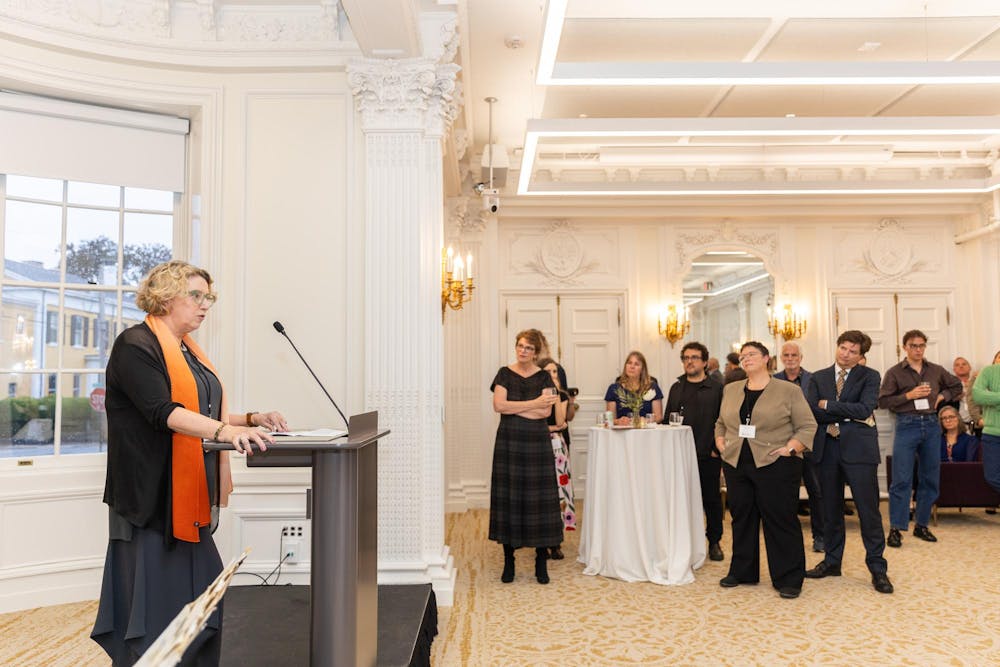Brown’s Cogut Institute for the Humanities hosted a dedication ceremony for its new home in the renovated Andrews House this Thursday.
At the private event, President Christina Paxson P’19 P’MD’20, Institute Director Amanda Anderson and affiliated faculty spoke of how the new hub will foster opportunities for discussion, collaboration and community within the world of humanities.
Located at 13 Brown St., Andrews House housed the Africana Studies/Rites and Reason Theatre department for a year before it was reconstructed in 2023. Even earlier, the building had been used for Health Services.
“I’ve already spoken to two people who said that they remember living in this building with mononucleosis,” Paxson said. “I have to say this makes a much better humanities institute than a health center.”
Andrews House was built by architect Ogden Codman, Jr. in 1900 as a winter home for textile magnate Alfred M. Coats. Afterward, the building was briefly used as the Rhode Island governor’s mansion. When Brown purchased the property, it served as the Faculty Club before becoming an infirmary in the 30s.
At the event, Paxson spoke of the importance of a community hub for interdisciplinary learning.
“Through studying the humanities, we develop the habits of mind, critical thinking, deep reading, productive dialogue, and the ability to hone our sense of what we value and what we want our place in the world to be,” she said. “And that’s the kind of work that I hope happens here.”
Prior to the ceremony, The Herald toured the building to learn more about the property’s history and how the renovation seeks to create a new future for cross-humanities study at Brown.
When one first walks into the establishment, the marble floor, high ceilings and white spiral staircase set it apart from most buildings on campus.
On the first day of class, Ava Pellagrini ’26 thought the first floor resembled “a museum.” Pellagrini currently takes a Postcolonial literature class with Professor Olakunle George in the building.
“It was gorgeous,” she told The Herald.
When the building was built, “architecture was sort of elaborate and ornate,” said Gregory Kimbrell, the institute’s communications manager. But, “at the time this building was (actually) considered stripped back and going back to the basics,” he said.
“Before Brown rewrote everything the building used to be, they wanted us to recognize it for what it was,” said Catie Manning ’25, who researched much of the history people now know about Andrews House last semester under Damien Mahiet, director of academic programs at the Cogut Institute and a lecturer in Humanities.
Manning and her colleagues used the archives at the John Hay Library and newspaper clippings to trace back the history of the building.
According to Kimbrell, one of the main goals of the renovation was to “restore the building to what it had been like before the infirmary” while updating it to the needs of Brown students and faculty.
For example, the first-floor ballroom — which entertained dignitaries in the time of the governor’s mansion — now serves as the premiere event space for scholars at the institute.

Next door, what used to be a dining space is now a reception room, Kimbrell explained. The room is also used to host weekly seminars for The Cogut Institute’s undergraduate fellowship.
On the second floor, visitors can find several centers and initiatives that reside in the institute, including the Center for the Study of the Early Modern World and the new Center for Environmental Humanities — which Kimbrell hopes can expand into a graduate certificate or concentration.

A kitchen, a library and the building’s largest seminar room reside on the third and final floor of Andrews House.

According to Anderson, the communal spaces have been drawing students already. “We were concerned about creating community, and making it a place where people would want to gather, would want to study, would want to hang out,” she said.

Outside the building, Kimbrell pointed to the green space, which used to be a parking lot. Now, the area has an accessible ramp and benches for all to sit on. “A big part of this was to make this space feel more like a part of Brown,” he said.
Daniel Newgarden ’25, an undergraduate fellow at the institute, is enjoying the new space and the opportunities the fellowship has provided.
“The environment has been really wonderful for having a cohort of people, both at the undergraduate level and then across the University — graduate, postdoc and Faculty Fellows,” he said. “It’s a rare kind of intergenerational group … where we are all using the same kind of grounding philosophy of humanistic inquiry.”
For Anderson, that is what the institute is all about.
“Brown has such dynamic humanities scholars, and it has such a strong tradition of being strong in the humanities,” said Anderson. The events, lecture series and seminars “where we have a two-hour conversation” she said, “is like my church.”
Correction: A previous version of this article stated that Andrews House housed the Africana Studies/Rites and Reason Theatre department for two years. The department was only house there for one year. The Herald regrets the error.
Clarification: This article has been updated to better reflect that Kimbrell was referring to the new Center for Environmental Humanities when she described a potential graduate certificate or concentration, not the Cogut Institute for the Humanities.

Sanai Rashid lives in Long Island, New York. As an English and Economics concentrator, she is passionate about storytelling and how numbers and data create narratives in ways words alone cannot. When she is not writing, you can find her trying new pizza places in Providence or buying another whale stuffed animal.





